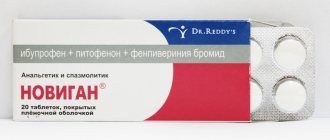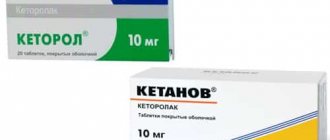Ketanov 10 mg 100 pcs. film-coated tablets
pharmachologic effect
NSAID, derivative of pyrrolysine-carboxylic acid. It has a pronounced analgesic effect, and also has anti-inflammatory and moderate antipyretic effects. The mechanism of action is associated with inhibition of the activity of COX, the main enzyme in the metabolism of arachidonic acid, which is a precursor of prostaglandins, which play a major role in the pathogenesis of inflammation, pain and fever.
Composition and release form Ketanov 10 mg 100 pcs. film-coated tablets
Tablets - 1 tablet: ketorolac tromethamine 10 mg.
10 pieces. — contour cell packaging (10) — cardboard packs.
Description of the dosage form
Film-coated tablets.
Directions for use and doses
For adults, when taken orally - 10 mg every 4-6 hours, if necessary - 20 mg 3-4 times a day.
For intramuscular administration, a single dose is 10-30 mg, the interval between injections is 4-6 hours. The maximum duration of use is 2 days.
Maximum doses: when taken orally or intramuscularly - 90 mg/day; for patients weighing up to 50 kg, with impaired renal function, as well as for persons over 65 years of age - 60 mg/day.
Pharmacodynamics
The analgesic effect occurs after approximately 30 minutes, the maximum analgesic effect develops after 1-2 hours. The duration of the analgesic effect is 4-6 hours or more, depending on the dose. Does not have a sedative or anxiolytic effect, does not affect opioid receptors. It does not have a depressant effect on the respiratory center and does not enhance respiratory depression and sedation caused by opioid analgesics. Does not cause drug dependence. No withdrawal symptoms occur after abrupt cessation of use. Suppresses platelet aggregation and may cause prolongation of bleeding time. Restoration of platelet function occurs 24-48 hours after discontinuation of the drug.
Pharmacokinetics
When taken orally, it is absorbed from the gastrointestinal tract. Cmax in blood plasma is achieved 40-50 minutes after both oral and intramuscular administration. Eating does not affect absorption. Plasma protein binding is more than 99%.
T1/2 ;- 4-6 hours both after oral administration and after intramuscular administration.
More than 90% of the dose is excreted in the urine, unchanged - 60%; the remaining amount is through the intestines.
In patients with impaired renal function and the elderly, the elimination rate decreases, T1/2 increases.
Indications for use Ketanov 10 mg 100 pcs. film-coated tablets
For short-term relief of moderate and severe pain of various origins.
Contraindications
Erosive and ulcerative lesions of the gastrointestinal tract in the acute phase, the presence or suspicion of gastrointestinal bleeding and/or cerebral hemorrhage, a history of blood coagulation disorders, conditions with a high risk of bleeding or incomplete hemostasis, hemorrhagic diathesis, moderate and severe renal dysfunction ( serum creatinine content more than 50 mg/l), the risk of developing renal failure due to hypovolemia and dehydration; “aspirin triad”, bronchial asthma, nasal polyps, history of angioedema, preventive pain relief before and during surgery, childhood and adolescence up to 16 years of age, pregnancy, childbirth, lactation, hypersensitivity to ketorolac, acetylsalicylic acid and other NSAIDs .
Application of Ketanov 10 mg 100 pcs. film-coated tablets during pregnancy and breastfeeding
Contraindicated during pregnancy, during childbirth and during lactation (breastfeeding).
Ketorolac is contraindicated for use as a premedication, maintenance of anesthesia and for pain relief in obstetric practice, since its influence may increase the duration of the first stage of labor. In addition, ketorolac may inhibit uterine contractility and fetal circulation.
Use with caution in patients with impaired renal function.
Use in children
Contraindicated in children and adolescents under 16 years of age.
special instructions
Use with caution in patients with impaired liver and kidney function, chronic heart failure, arterial hypertension, in patients with erosive and ulcerative lesions of the gastrointestinal tract and a history of bleeding from the gastrointestinal tract.
Ketorolac should be used with caution in the postoperative period in cases where particularly careful hemostasis is required (including after resection of the prostate gland, tonsillectomy, in cosmetic surgery), as well as in elderly patients, because The half-life of ketorolac is prolonged and plasma clearance may be reduced. In this category of patients, it is recommended to use ketorolac in doses close to the lower limit of the therapeutic range. If symptoms of liver damage, skin rash, or eosinophilia appear, ketorolac should be discontinued. Ketorolac is not indicated for use in chronic pain syndrome.
Impact on the ability to drive vehicles and operate machinery
If drowsiness, dizziness, insomnia or depression appear during treatment with ketorolac, special care must be taken when engaging in potentially hazardous activities that require increased attention and speed of psychomotor reactions.
Overdose
Symptoms: (with a single dose) abdominal pain, nausea, vomiting, peptic ulcers, impaired renal function (these symptoms disappeared after discontinuation of the drug). Treatment: symptomatic therapy. Dialysis does not significantly remove ketorolac from the blood.
Side effects of Ketanov 10 mg 100 pcs. film-coated tablets
From the cardiovascular system: rarely - bradycardia, changes in blood pressure, palpitations, fainting.
From the digestive system: nausea, abdominal pain, diarrhea are possible; rarely - constipation, flatulence, feeling of gastrointestinal fullness, vomiting, dry mouth, thirst, stomatitis, gastritis, erosive and ulcerative lesions of the gastrointestinal tract, liver dysfunction.
From the central nervous system and peripheral nervous system: anxiety, headache, drowsiness are possible; rarely - paresthesia, depression, euphoria, sleep disturbances, dizziness, changes in taste, visual disturbances, motor disorders.
From the respiratory system: rarely - respiratory failure, attacks of suffocation.
From the urinary system: rarely - increased frequency of urination, oliguria, polyuria, proteinuria, hematuria, azotemia, acute renal failure.
From the blood coagulation system: rarely - nosebleeds, anemia, eosinophilia, thrombocytopenia, bleeding from postoperative wounds.
From the metabolic side: ;possible increased sweating, swelling; rarely - oliguria, increased levels of creatinine and/or urea in the blood plasma, hypokalemia, hyponatremia.
Allergic reactions: possible skin itching, hemorrhagic rash; in isolated cases - exfoliative dermatitis, urticaria, Lyell's syndrome, Stevens-Johnson syndrome, anaphylactic shock, bronchospasm, Quincke's edema, myalgia.
Other: ;possible fever.
Local reactions: pain at the injection site.
Drug interactions
When ketorolac is used concomitantly with other NSAIDs, additive side effects may develop; with pentoxifylline, anticoagulants (including heparin in low doses) - the risk of bleeding may increase; with ACE inhibitors - there may be an increased risk of developing renal dysfunction; with probenecid - the plasma concentration of ketorolac and its half-life increase; with lithium preparations - a decrease in the renal clearance of lithium and an increase in its concentration in plasma is possible; with furosemide - reducing its diuretic effect.
When using ketorolac, the need for the use of opioid analgesics for pain relief is reduced.
Release form and composition
Ketanov is available in several pharmacological forms: tablets and solution for intramuscular administration. The tablets are white and round in shape. On one of their surfaces there is an engraving KTV. Ketanov tablets are available in cardboard packages containing 1, 2, 3 or 10 blisters.
The injection solution has a pale yellow tint and is used to quickly relieve unbearable pain. Typically, treatment with the drug in this form of release is carried out in hospitals. The liquid for injection is packaged in ampoules of 1 ml each. The ampoules are placed in cardboard packaging and sold in packs of 5 or 10 pieces.
The main substance in the solution and tablets is ketorolac trometamol. Auxiliary components in the tablets:
- starch;
- magnesium stearate;
- silicon dioxide, etc.
In addition to the active ingredient, the injections also include:
- purified water;
- ethanol;
- disodium edadate.
Before taking Ketanov, it is very important to study the instructions for use in order to exclude allergic reactions to its substances in its composition. Auxiliary components do not have an analgesic or anti-inflammatory effect. They are necessary in order to give the drug a certain shape and consistency and increase its shelf life.
Compatibility with other drugs
People who additionally take other medications need to pay attention to the drug compatibility of Ketanov. Failure to comply with the rule can lead to serious side symptoms during therapy.
Ketanov is not recommended to be combined:
- With other NSAIDs. In this case, the risk of exacerbation of gastrointestinal pathologies that occur in a chronic form increases. While taking several painkillers, internal bleeding often occurs.
- With acetyl acid and products containing paracetamol as an active ingredient.
- With thrombolytics due to the risk of blood thinning.
- With diuretics. In this case, the therapeutic effect of the two drugs is reduced.
- With insulin. Ketanov enhances the hypoglycemic effect of insulin.
Reviews
Anton, 37 years old. Ketanov toothache tablets act quickly and help eliminate spasms for several hours, but you should not abuse them. If you experience pain, you should contact your dentist as soon as possible.
Irina, 41 years old. At the dacha I got a toothache. I couldn’t see a dentist because I was too far from the city. The pain was so severe that it radiated into the ears and eyes. I took the only painkiller that was in my first aid kit – Ketanov. The product relieved the pain within 15 minutes and allowed me to spend the weekend at the dacha without any problems. I got an appointment with a doctor only 4 days later. The dentist said that I acted irresponsibly, because Ketanov has a lot of side effects.
Vitaly, 38 years old. I can’t speak unequivocally about the drug. I only used it once, when I damaged the root of a tooth. I took it as a preventive measure so that I wouldn’t feel pain later. However, my injury was not accompanied by pain. This drug does not help my brother at all. He says it also hurts to chew food and drink. I think you shouldn’t count on a special therapeutic effect from the drug for serious problems. It's better to go to the dentist right away.
Action
The drug has a complex effect on the human body:
- anti-inflammatory;
- antipyretic;
- painkiller.
The medicine does not affect the central nervous system of patients and their moral state. The active component begins to act immediately after entering the blood. It stops the production of prostaglandins, which are responsible for the perception of pain. After taking the tablets or administering the solution, a person ceases to feel not only toothaches, but also spasms of other localizations.
The effect of taking Ketanov is observed after 30-40 minutes and lasts for 5-8 hours. How long it takes for Ketanov to take effect largely depends on its release form, the intensity of pain in a person and the patient’s individual susceptibility to medications.
The components of the drug are excreted along with urine, so it is not recommended to drink it for people who have problems with kidney function. Ketanov is excreted in the urine in the form of metabolites.
Danger of use
If used incorrectly and for too long, Ketanov can cause side effects such as:
- Allergic reactions. The condition is manifested by skin rashes, difficulty breathing (less commonly, anaphylactic shock and asphyxia).
- Digestive disorders - constipation, loose stool, flatulence.
- Hypertension.
- Kidney pathologies.
In case of an overdose of the drug, it is necessary to rinse the stomach with plenty of water and take any sorbent.
Indications for use
Among the dental indications for taking the drug, the following should be noted:
- tooth extraction and treatment;
- implantation;
- prosthetics;
- inflammation of the nerve ending of the tooth;
- cyst;
- advanced forms of caries;
- flux;
- periodontal disease.
The tablets also help with muscle pain and headaches. Other indications for their use:
How to relieve toothache
- otitis;
- tumor processes;
- pain after childbirth;
- hepatic colic;
- muscle spasm;
- osteochondrosis;
- radicular syndrome;
- osteoarthritis and osteoarthritis;
- pinched sciatic nerve.






